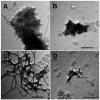Evaluation of N- and O-Linked Indole Triazines for a Dual Effect on α-Synuclein and Tau Aggregation
- PMID: 37818657
- PMCID: PMC10624178
- DOI: 10.1021/acschemneuro.3c00464
Evaluation of N- and O-Linked Indole Triazines for a Dual Effect on α-Synuclein and Tau Aggregation
Abstract
Alzheimer's disease (AD) is the most prevalent neurodegenerative disorder underlying dementia in the geriatric population. AD manifests by two pathological hallmarks: extracellular amyloid-β (Aβ) peptide-containing senile plaques and intraneuronal neurofibrillary tangles comprised of aggregated hyperphosphorylated tau protein (p-tau). However, more than half of AD cases also display the presence of aggregated α-synuclein (α-syn)-containing Lewy bodies. Conversely, Lewy bodies disorders have been reported to have concomitant Aβ plaques and neurofibrillary tangles. Our drug discovery program focuses on the synthesis of multitarget-directed ligands to abrogate aberrant α-syn, tau (2N4R), and p-tau (1N4R) aggregation and to slow the progression of AD and related dementias. To this end, we synthesized 11 compounds with a triazine-linker and evaluated their effectiveness in reducing α-syn, tau isoform 2N4R, and p-tau isoform 1N4R aggregation. We utilized biophysical methods such as thioflavin T (ThT) fluorescence assays, transmission electron microscopy (TEM), photoinduced cross-linking of unmodified proteins (PICUP), and M17D intracellular inclusion cell-based assays to evaluate the antiaggregation properties and cellular protection of our best compounds. We also performed disaggregation assays with isolated Aβ-plaques from human AD brains. Our results demonstrated that compound 10 was effective in reducing both oligomerization and fibril formation of α-syn and tau isoform 2N4R in a dose-dependent manner via ThT and PICUP assays. Compound 10 was also effective at reducing the formation of recombinant α-syn, tau 2N4R, and p-tau 1N4R fibrils by TEM. Compound 10 reduced the development of α-syn inclusions in M17D neuroblastoma cells and stopped the seeding of tau P301S using biosensor cells. Disaggregation experiments showed smaller Aβ-plaques and less paired helical filaments with compound 10. Compound 10 may provide molecular scaffolds for further optimization and preclinical studies for neurodegenerative proteinopathies.
Keywords: antiaggregation compounds; hyperphosphorylated tau; paired helical filaments; tau; α-Synuclein.
Conflict of interest statement
The authors declare no competing financial interest.
Figures












References
Publication types
MeSH terms
Substances
Grants and funding
LinkOut - more resources
Full Text Sources
Medical
Miscellaneous

